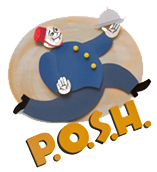Victorian Silverplate & Blue Glass Mustard Pot
Victorian Silverplate & Blue Glass Mustard Pot
SOLD
The first recorded record of mustard in England appeared in 1390 in a book called The Forme of Cury, published by one of King Richard II’s master cooks. It featured mustard balls, which were a coarse-ground mustard seed combined with flour and cinnamon, moistened, rolled into a ball and dried for preservation. This pungent style of mustard is now considered something of a national condiment in England, used at table to complement everything from roast dinners and sandwiches to sausages, savory meat pies and cheese. By the 16th century, its popularity was such that it was mentioned in William Shakespeare's plays. Three centuries later and now nearly synonymous with prepared English mustard, is Colman's of Norwich with its bright yellow tin. Established in 1814, it quickly became a significant brand and export within British cuisine, receiving a royal warrant for its quality that is revered to this day.
Found at market in the north of England, we are enamored with this Antique Victorian Silverplate & Blue Glass Mustard Pot produced by premier silversmith Elkington & Co. in 1851, the year of the Queen Victoria's Great Exposition. This exceptional petite pot originally designed for mustard service at table, is resplendent with articulated silver details encircling a brilliant cobalt blue glass liner. Embellished with a decorative pierced scene that flows towards the handsome handle on either side of a prominent front escutcheon, the pot is finished with a paneled hinged lid surmounted with an impressive cast silver scrolling thumbpiece reminiscent of a majestic fan.
Depicting a flora and fauna English hunt scene that incorporates botanicals along with a hunting dog and game bird, the finely detailed pot is finished with a distinctive, scrolling handle that promises to make passing the mustard (or the jam or the sugar or the chutney!) a joy. Rich in history, with a design that honors both form and function, this handsome pot is sure to present your mustard in a manner befitting its culinary legacy
Strictly one-of-a-kind and subject to prior sale. 4.25" in diameter In very good restored condition.
Learn More About Mustard
Its name—mustard in English, moutarde in French, mostarda in Italian—is thought to come from a contraction of the Latin mustum ardens meaning "burning must." This is a reference to the spicy heat of mustard seeds and the ancient practice of the Romans of mixing the ground seeds with must, the fresh, unfermented juice of wine grapes.
Mustard is one of the earliest spices on record, appearing in Sanskrit manuscripts around 3000 BC. It is thought to be one of the first crops to be domesticated, and mustard was used throughout ancient Egypt, India, and China. The condiment was first found for sale in Paris beginning in the 1200s.














